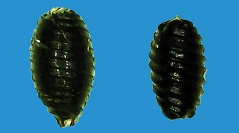

 Cryptogamie, Algologie
43 (12) - Pages 189-200
Cryptogamie, Algologie
43 (12) - Pages 189-200The precise determination of charophytes to the species level is important for many reasons, but the common morphological taxonomic characteristics, particularly between morphologically similar taxa can be insufficient or misleading. The aim of our study was to create a comparative analysis of the oospore’s morphometric parameters in morphologically similar taxa such as Chara globularis Thuil., C. “connivens” P.Salzmann ex A.Braun, C. braunii C.C.Gmel. and C. baueri A.Braun (from Serbia). The potential for applying oospore features in species delineation was assessed, along with the interpopulation variability of oospore parameters in geographically remote populations of C. globularis and C. braunii. Common oospore parameters (height, width, number of ridges, width of fossa, and distance between the apical pole of the oospore and its widest part) were measured and the isopolarity index and anisopolarity index indices were calculated. Both interpopulation variability and interspecific differences were confirmed using oospore morphology for the selected charophyte species. Although interpopulation variability does in fact exist, oospore parameters clearly differ between morphologically similar taxa. These results are important from a taxonomic perspective, but also from the aspect of diaspore bank characterization and its potential application in restoration projects. The results also justify the need for the development of oospore identification keys at the local and regional level, particularly in the regions where they are completely lacking (e.g. Balkans). Collecting more data on oospore morphometry is necessary for our results to be widely used.
Charophytes, oospores, species delineation